For many fascinated by history, the allure of Victorian gowns and the elegance of a bygone era hold a special charm. Coupled with a love for the American Southwest and pioneer heritage, it’s natural to ponder the distinctive clothing of women on the Western frontier and how it differed from Eastern styles of the time. Pioneer women’s wardrobes were a fascinating blend of practicality, modesty, and a desire to maintain a sense of civilization amidst the challenges of frontier life. This exploration delves into the essential elements of Pioneer Clothes For Women, uncovering the necessities and nuances of their frontier fashion.
Defining the Frontier Wardrobe
In this context, “frontier” refers to the regions west of Missouri and Arkansas, roughly spanning the years 1850-1890. The focus is on the clothing worn by women homesteaders and those in settlement communities, primarily white settlers migrating westward from the East. What’s compelling about pioneer clothing is its shift in emphasis from status and wealth to the shared experience and aspirations of families venturing into the unknown. Functionality and adaptability became paramount in their clothing choices.
Undergarments: The Foundation of Pioneer Women’s Attire
Interestingly, the underclothes of women in frontier areas were not drastically different from those worn in eastern cities. The chemise, a light cotton slip, remained a fundamental undergarment, valued for hygiene and frequent washing. Pantalets, made from flannel or cotton, were another common layer, serving purposes of modesty, acting as a precursor to modern underwear.
Contrary to assumptions of a completely stripped-down wardrobe, corsets were a regular feature of pioneer women’s attire. These women, driven by hopes for a better future, whether economic or religious, often considered themselves “proper” and maintained standards of dress from their former lives. The corset was a garment deeply ingrained in the fashion norms of the era.
While some women might loosen or forgo corsets for strenuous housework, most pioneer women brought corsets west and wore them as often as possible, reflecting a desire to uphold societal expectations even in a rugged environment.
Following the corset came petticoats, often multiple layers depending on the weather and formality of the occasion. Stockings were essential for venturing outside or receiving guests, held up by garters or tucked into pantalets – a method that might sound less than comfortable today.
Fabrics: Practicality and Availability
Calico emerged as the quintessential fabric for pioneer clothing. Often envisioned as quaint floral prints, calico is actually a type of plain-woven cotton fabric, slightly heavier than muslin but lighter than canvas. Its attributes – lightweight, durable, and easy to clean – made it ideal for the demands of outdoor frontier life. General stores offered calico in various dyed options, and women also dyed fabric themselves using store-bought or natural dyes derived from plants like leaves, bark, berries, and fruits.
Cotton and silk fabrics were reserved for “Sunday best” and more formal dresses, and many women brought such garments from their previous homes in the East.
Fabric availability depended heavily on access to general stores, which varied across the frontier. In more remote areas, families often had to produce their own fabrics, a craft that deserves its own dedicated exploration.
Daily Wear: Adapting to Frontier Life
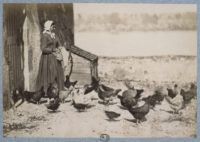 Pioneer woman in a field wearing a bonnet and simple dress.
Pioneer woman in a field wearing a bonnet and simple dress.
Regardless of their backgrounds, women in frontier settlements were integral to establishing and maintaining homes and farms. Their days were filled with cooking, cleaning, childcare, laundry, and often fieldwork. The family’s survival depended on everyone’s labor, with no outsourcing of domestic duties. Pioneer women quickly adapted to a life of physical work.
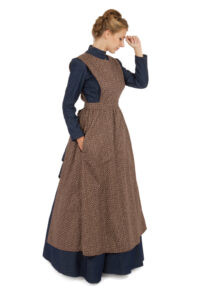 Close-up of a pioneer calico apron.
Close-up of a pioneer calico apron.
While pioneer dresses mirrored general dress styles with fitted bodices and full skirts, practical modifications were essential. Skirts for everyday wear were hemmed approximately three inches shorter to facilitate movement. Weights were sometimes sewn into hems to prevent skirts from blowing up in windy conditions, ensuring modesty and practicality.
Bodices remained fitted, but sleeves were loosened and extended to the wrists, paired with high collars for sun protection.
Laundry was a significant undertaking. Interestingly, the concept of a “wash dress” emerged. As mentioned in How the West Was Worn by Chris Enss, a two-piece white cotton dress with a printed background gained popularity around 1867 due to its easy care. Known as the “wash dress,” it was available in stores and replicated by seamstresses, worn across socioeconomic lines. This “wash dress” highlights the adaptation of fashion to meet the practical needs of frontier living.
Sunday Best: Maintaining Social Graces
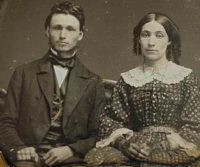 A pioneer couple dressed in their Sunday best attire.
A pioneer couple dressed in their Sunday best attire.
Even with the isolation of frontier life, settlements often developed churches, and church attendance became a social norm. While accounts exist of women in impoverished communities attending church barefoot, it was more common for women to own dresses specifically for Sundays. However, historical records often lean towards more privileged settlers, making it challenging to definitively state the most typical scenario.
“Sunday best” pioneer clothes for women closely resembled fashionable city attire. Full skirts over petticoats and corsets were standard. Sleeve styles, such as bell, leg-o-mutton, or pagoda sleeves, reflected current trends. Skirt styles also followed fashion, transitioning through crinoline, hoop, and bustle silhouettes depending on the decade.
Color choices for Sunday dresses varied with age and marital status. Younger, newly married women favored lighter colors, while older women shifted to darker hues. Fashionable hats, kid gloves, and low-heeled boots completed the Sunday ensemble.
Social Occasions: Dressing for Community
For those with the means, a separate dress was often reserved for social gatherings beyond church. Dances, holiday celebrations, picnics, and community events were vital for social connection. Pioneer women, like their Eastern counterparts, valued dressing appropriately for these occasions.
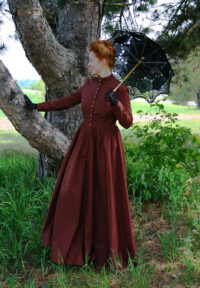 A woman in a formal pioneer dress, possibly for church or social events.
A woman in a formal pioneer dress, possibly for church or social events.
These “social” dresses were treasured items. Women might order fabrics from general stores and eagerly await the chance to create fashionable outfits. Godey’s Ladies Book was a popular source of fashion inspiration, circulated among frontier women who enthusiastically copied dress patterns and styles.
Fabric availability for these dresses depended on the proximity to towns and general stores. In many cases, women had limited dress options, using their finest dress for special events and embellishing it with accessories. Hand-crocheted collars and shawls were popular additions, along with other accessories that added flair to their frontier wardrobes.
Accessories: The Finishing Touches
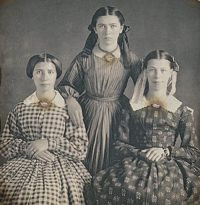 Two young pioneer girls with bonnets and aprons.
Two young pioneer girls with bonnets and aprons.
Accessories played a surprisingly significant role in pioneer women’s clothing. Beyond basic garments, these finishing touches were highly valued. Jewelry and accessories were emphasized in historical accounts, highlighting their importance in completing an outfit.
Pioneer women accessorized with:
- Aprons
- Boots
- Brooches
- Lockets
- Earrings
- Precious stones and metals (when available)
- Hair adornments
- Hats
- Collars and cuffs
- Gloves
- Undersleeves
- Parasols
- Fans
- Handbags
- Shawls
Legacy of Pioneer Fashion
Exploring pioneer clothing for women reveals the resourcefulness and resilience of women on the frontier. Despite the hardships of frontier life, they maintained a connection to fashion and societal norms, adapting their clothing to meet practical needs while preserving a sense of personal style and community. The enduring appeal of “prairie style” and “western wear” today reflects the lasting impact of pioneer fashion and the women who shaped it. Their clothing tells a story of adaptation, resilience, and the enduring human desire for beauty and self-expression, even in the most challenging circumstances.
Embody the Pioneer Look:
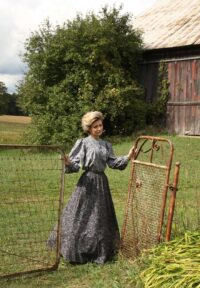 A woman modeling pioneer clothing consisting of a blue blouse and skirt in a field.
A woman modeling pioneer clothing consisting of a blue blouse and skirt in a field.
Explore our Pioneer Clothing Collection
